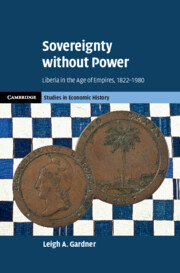Book contents
- Sovereignty without Power
- Cambridge Studies in Economic History
- Sovereignty without Power
- Copyright page
- Dedication
- Contents
- Figures
- Maps
- Tables
- Preface
- Acknowledgments
- 1 Reconstructing the Fragments
- Part I Foundations
- 2 Before the Dragons Came
- 3 Black Americans in West Africa
- Part II The Art of Survival
- Part III Sovereignty for Sale?
- Book part
- References
- Index
2 - Before the Dragons Came
from Part I - Foundations
Published online by Cambridge University Press: 27 October 2022
- Sovereignty without Power
- Cambridge Studies in Economic History
- Sovereignty without Power
- Copyright page
- Dedication
- Contents
- Figures
- Maps
- Tables
- Preface
- Acknowledgments
- 1 Reconstructing the Fragments
- Part I Foundations
- 2 Before the Dragons Came
- 3 Black Americans in West Africa
- Part II The Art of Survival
- Part III Sovereignty for Sale?
- Book part
- References
- Index
Summary
Histories of Liberia are often criticized for focusing only on the Americo-Liberian elite, ignoring the indigenous majority. This chapter reconstructs what is known about the economyand political institutions of the region that became Liberia before the arrival of migrants from the United States. Drawing on both qualitative evidence from historical accounts and anthropological research as well as more recent techniques for the quantitative comparison of precolonial economies, it provides a new account of what was known as the Grain Coast and its hinterland. National averages and later proxy data show that Liberia was less densely populated, with poorer soils and less centralized states than other parts of West Africa. However, these averages mask considerable variation in levels of commercialization and the organization of institutions within what became Liberia, particularly as migrations from other parts of West Africa during the medieval and early modern period helped connect the interior to regional trade networks.
- Type
- Chapter
- Information
- Sovereignty without PowerLiberia in the Age of Empires, 1822–1980, pp. 33 - 57Publisher: Cambridge University PressPrint publication year: 2022

